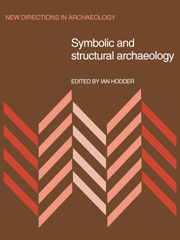Book contents
- Frontmatter
- Contents
- List of contributors
- Preface
- Part one The development of theory
- Part two The search for models
- Part three Application: the analysis of archaeological materials
- 11 Boundedness in art and society
- 12 Ideology, symbolic power and ritual communication: a reinterpretation of Neolithic mortuary practices
- 13 Ideology, change and the European Early Bronze Age
- 14 Sequences of structural change in the Dutch Neolithic
- Part four Commentary
- Index
11 - Boundedness in art and society
Published online by Cambridge University Press: 27 February 2010
- Frontmatter
- Contents
- List of contributors
- Preface
- Part one The development of theory
- Part two The search for models
- Part three Application: the analysis of archaeological materials
- 11 Boundedness in art and society
- 12 Ideology, symbolic power and ritual communication: a reinterpretation of Neolithic mortuary practices
- 13 Ideology, change and the European Early Bronze Age
- 14 Sequences of structural change in the Dutch Neolithic
- Part four Commentary
- Index
Summary
Conkey examines social boundaries and their relation to the structure of style and design, with particular reference to Palaeolithic art. The style or structure of Palaeolithic art is shown to be characterised by a number of structural features such as non-differentiation of levels, and lack of design-field. Iconic representations of the type found in the Upper Palaeolithic are suggested as having an evolutionary primacy over more complex symbolic organisation, and the development of this ability in the Upper Palaeolithic is linked to the explosion in the richness and variety of material culture at this time. There is evidence for an emphasis on continuity between the background and the picture, between the natural and the cultural worlds, and a lack of directionality in the organisation of the art. Questions are asked concerning how structural congruences and the structural organisation of differences emerged during the Palaeolithic.
This paper is an attempt to weave together some emerging ideas on how to approach prehistoric artforms or a prehistoric art style from a structuralist perspective. It is written with firm conviction that such a perspective is not just useful; we must make our inferences about past human life from the structure of archaeological data. I do not intend to consider what has been wrong or off-the-track in archaeology, particularly with regard to the three topics I have chosen to pursue here: social boundaries, style and design analysis. Most archaeologists know well how these three topics tend to coincide in archaeological research. Instead, I will briefly present the notion of social boundaries as just one level and manifestation of discontinuity in human life.
- Type
- Chapter
- Information
- Symbolic and Structural Archaeology , pp. 115 - 128Publisher: Cambridge University PressPrint publication year: 1982
- 23
- Cited by

